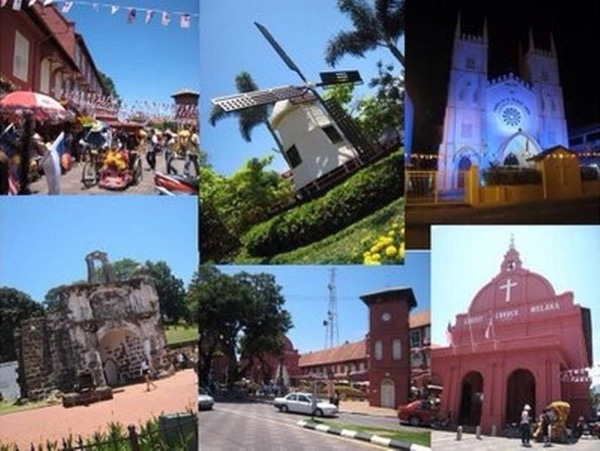20 October 2012 | last updated at 12:14AM
Old Malacca on St Paul's Hill
By PHILIP LIM | streets@nstp.com.my 0 comments
MALACCA: THERE'S an old scent of history on St Paul's Hill in Malacca that draws tens of thousands of visitors there every month.
There are about 10 old Portuguese tombstones inside the church.
1 / 7
Even though the roof is missing, with only the walls left standing, visitors who walk on its grounds can't help but feel that history has left a long trail of invisible footprints left behind by forgotten Christian missionaries.
The original building on the hill was built in 1521 as a chapel dedicated to the Blessed Virgin Mary.
The chapel was named Nossa Senhora da Annunciada or Our Lady of the Hill. In 1548, the Bishop of Goa handed over control of the chapel to the Jesuits and a missionary named Francis Xavier took over the deed.
Renovations to the chapel took place in 1556, 1590 and 1592. In due course, the chapel was renamed Igreja de Madre de Deus or Church of the Mother of God.
When the Dutch took over Malacca in 1641, the church was renamed St Paul's Church. One hundred eighty-three years later in 1824, the British gained control of Malacca but the name of the hill remained.
On any given day, one will find on St Paul's Hill souvenir pedlars and artists who seem to be drawn there more by the place's serenity than by anything else.
Foo is one of them. He is on the lighter side of his 50s, but looks like someone who has emerged unscathed by the Flower Power of the 1960s.
His greying moustache and his lean frame give the impression that he is a bohemian seeking his fortunes amid 400-year-old ancient ruins. Sporting shoulder-length hair, a red jockey cap and cropped pyjama-style pants, Foo has that enigmatic smile that reveals he has seen far more of life than he is willing to share with strangers.
But once he warms up to you, Foo, who is sometimes called Patrick, is quick to recount tales of those early years when he was a fisherman. He weathered the storms on the high seas for two or three years before he realised that it was not his true path in life.
"During those fishing years, I was out at sea for two or three days at a time. Occasionally, it was about one to two weeks," said Foo.
The weather was unforgiving and life sometimes seemed to hang in the balance, added Foo with a whimsical smile.
About 10 years ago, Foo decided he had had enough of the rough seas, scorching sun and vacillating fortunes. He returned to being a landlubber on terra firma where his feet did not have to sway.
With the help of some business friends, he obtained an ample supply of prints of old Malacca. The prints, popular among tourists, are given sepia tones to lend an old charm to the historical city.
Among the 20-odd pictures of old Malacca are scenes of Jonker Street in 1890, Heeren Street in 1910, Malacca River in 1880 and Kwee Meng Kuang footbridge in 1890.
A batch of five prints is sold at RM20. For a KL resident, the price seemed immensely reasonable. In Jonker Street, where some photo shops are located, a similar old print which is framed is priced at RM45 each.
Foo readily admits that he is not an artist and that the items spread on the floor are not his work. Sitting on a stool in the corner of the interior of the church, the congenial individual seems to like life as it is right now.
His "work station" is in the rear of roofless church, which houses an old burial vault and Portuguese tombstones removed from the grounds in the 1930s.
The Portuguese tombstones, which number about 10, form a boundary of sorts around Foo's "exhibition area".
A few feet from Foo is a sign in three languages (Bahasa Malaysia, English and Dutch) that says "laid to rest here is Ioanna six who was born in Tayoan, wife of Jacobus Pedel, a merchant and harbour master for Malacca town. Departed this life on 1 January 1696 at the age of 40 years, 9 months, 15 days also, before her on 21 May, 1695, their son Jacobus Pedel Junior passed away at age less 2 days to 7 months".
With these centuries-old tombstones and relics on St Paul's Hill, the old Malacca that Foo somehow seems to personify, has come alive with its ancient walls and tombstones speaking in whispered tones about lives come and gone.
This former holy ground, like many others, is not without its own tale and mystery. The story lies in a statue of St Francis Xavier, erected in 1952, that has a broken right arm, at the front of the church.
The statue was to mark the 400th anniversary of the saint's stay in Malacca. One day after the statue was put up, a large tree fell and broke the arm.
It would not have been an unusual occurrence if not for the fact that in 1614, the right forearm of St Francis Xavier was removed from his body as a relic.
Today on St Paul's Hill, if you care to listen in silence to the whispers of the slow, incoming sea breeze, you, too, may hear something.
Read more: Old Malacca on St Paul's Hill - Central - New Straits Times http://www.nst.com.my/streets/central/old-malacca-on-st-paul-s-hill-1.159199#ixzz2A0Y2BVki


